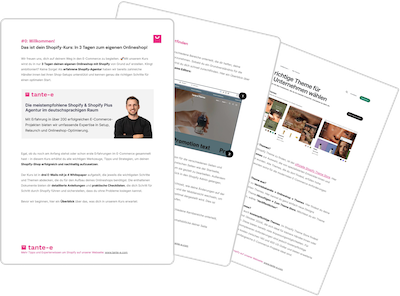From June 28, 2025, accessibility will be legally mandatory for most online shops in Germany. But what does this mean specifically for Shopify merchants?
These new accessibility requirements may seem complex at first glance, but they can be addressed with a structured approach and the right tools. For Shopify, this means your online store must meet WCAG Level AA standards by the specified deadline.
Our guide, based on the expertise of tante-e expert Constanze, shows you step by step how to implement the legal requirements in your Shopify store. Whether you've already taken initial steps or are starting from scratch, our tips will provide you with guidance and help you meet all requirements on time.
Note: This blog post serves as a general guide and does not claim to be complete or legally binding. For detailed questions regarding accessibility implementation or legal advice, we recommend consulting a qualified attorney.

Account Manager Constanze supports our tante-e clients in the continuous optimization of their online shops. She shares her expertise on accessible and legally compliant shop setup in the tante-e podcast ( YouTube , Spotify & Apple Podcasts ).
- Why Shopify Merchants Should Care About Accessibility
- Who does the Accessibility Act affect?
- To-Dos: How to make your Shopify store accessible (checklist)
- What are the consequences for retailers of non-compliance with the Accessibility Act?
- How can you test the accessibility of your online shop?
- Apps & tools for accessible Shopify stores
The most important information about accessibility prepared for you:
1. Why Shopify merchants should care about accessibility
With the introduction of the Accessibility Strengthening Act (BFSG), accessibility for online shops becomes not just an important issue, but a legal requirement. The law implements the European Accessibility Act (EAA), which creates uniform accessibility standards across Europe and focuses specifically on online commerce.
Specifically, this means that by June 28, 2025, online shops must meet the requirements of the international standard EN 301 549, which is based on the Web Content Accessibility Guidelines (WCAG) 2.1. The focus is on achieving WCAG level AA, which ensures that digital content is accessible to the majority of people with disabilities.
These requirements cover not only basic aspects such as accessible navigation and sufficiently high contrast, but also specific measures such as providing an accessibility statement and a contact point for feedback. Merchants who act early benefit from clear guidelines and avoid legal consequences – because the market surveillance authority can impose penalties or even temporarily suspend online trading for non-compliance.
Accessibility is no longer an optional extra, but an essential component of online stores. As a Shopify merchant, it's up to you to implement the requirements – both for legal compliance and the secure continued existence of your store.
2. Who does the Accessibility Act affect?
The Accessibility Improvement Act (BFSG) is aimed at all companies offering digital products and services in Germany. The requirements apply regardless of the industry, as long as the shop or digital offering is publicly accessible to enable people with disabilities to access digital services without restrictions.
2.1. What exceptions are there?
However, the law provides for some exceptions to protect smaller companies from disproportionate burdens. The following exceptions apply:
-
Small businesses: Are completely exempt from the requirements if the following conditions are met:
- Less than 10 employees
- Less than 2 million euros annual turnover
-
Medium-sized enterprises: Must provide a reasoned explanation if implementing accessibility is deemed economically or technically unfeasible. Conditions:
- Fewer than 50 employees
- Less than 10 million euros in annual turnover
For all other retailers, the implementation of the legal requirements by the deadline of June 28, 2025 is mandatory.
Together with our expert Constanze, we've recorded a full podcast episode covering the most important questions about setting up your Shopify store in a legally compliant, accessible manner. This article summarizes the key aspects. You can find out all the details in the full episode:
3. To-Dos: How to make your shop accessible
We recommend a structured approach to setting up an accessible Shopify store. We'll provide you with an overview of the most important steps here. You'll find a practical to-do list in our detailed checklist on "Accessibility on Shopify."
3.1 Structure and labeling
Important measures:
- Document titles: Make sure your store's tabs have descriptive titles (e.g., "About Us | Company Name").
- Headings and labels (WCAG 2.4.6): Headings and labels must clearly describe the topic or purpose.
- Alt texts for graphics:
- Linked graphics: Alt text describes the link destination.
- Functional graphics: Alt text explains the purpose.
- Informative graphics: Alt text describes the content.
- Decorative graphics: Alt text remains empty (
alt="").
3.2 Usability and navigation
Important measures:
-
Labels in the name (WCAG 2.5.3): UI components (e.g. buttons) must have the same name as the one visually represented (e.g. hover text).
For example, a button on a website visually displays the text "Buy Now." However, the underlying programming code describes the same button as "Checkout." Consistent labeling would prevent violations. -
Link purpose recognizable (WCAG 2.4.4): Link texts must be understandable on their own or in context.
For example, instead of using link text like “Click here” or “Learn more” without context, clear link text like “View our product overview” is compliant with the guidelines. - Keyboard usability (WCAG 2.1.1): All functions must be fully operable via the keyboard.
-
Visible Focus (WCAG 2.4.7): UI elements must have a visible focus state.
Example: When navigating using the keyboard, a navigation should indicate which element is currently focused, e.g., by changing the color.
3.3 Media and visual elements
Important measures:
- Videos with subtitles: Synchronized subtitles must describe both speakers and sounds.
- Contrast (WCAG 1.4.11): The text-to-background contrast must be at least 4.5:1. Colors must be distinguishable even for people with color vision deficiency.
- Moving content (WCAG 2.2.2): Movements in carousels or videos must not last longer than 5 seconds or must offer a stop function.
3.4 Readability and language
Important measures:
- Resizable text sizes (WCAG 1.4.4): Content must remain readable and usable at 200% zoom.
- Text spacing (WCAG 1.4.12): Ensure minimum spacing for line, letter, and word spacing.
- Understandable language: Use short, simple sentences without unclear abbreviations or foreign words.
3.5 Forms and input fields
Important measures:
- Accessible forms: Visible and clickable labels must be linked to the form field.
- Accessibility (WCAG 3.3): Provide clear labels and error messages.
3.6 Order and compatibility
Important measures:
- Reading order: Elements must be arranged in a meaningful order in the source code.
- Focus order (WCAG 2.4.3): The focus order of elements must be logical, meaning: Elements should appear in the HTML document in the order in which they are visually displayed.
- Compatibility (WCAG 4.1): Use correct markup to support assistive technologies.
4. What are the consequences for retailers of non-compliance with the Accessibility Act?
Failure to comply with the Accessibility Enhancement Act (BFSG) can have serious legal and business consequences for Shopify merchants. The law provides clear rules for how violations will be punished:
- Request for remediation: Merchants are requested to remedy the barriers within a specified timeframe.
- Fines for violations: Fines may be imposed for persistent non-compliance.
- Suspension of electronic commerce: In serious cases, the operation of the online shop may be temporarily suspended.
Consumers have the opportunity to report barriers in digital offerings directly. Such reports can also lead to an investigation by the market surveillance authority.
It is therefore essential for Shopify merchants to implement the law's requirements on time to avoid legal risks and financial losses. We recommend completing the implementation for your online store ideally before the June 2025 deadline to avoid potential penalties and operational restrictions.
How secure is Shopify? You can find the analysis in our blog.
5. How can you test the accessibility of your store?
Checking the accessibility of your Shopify store is an essential step to ensure compliance with legal requirements. We present various methods and tests that can help you assess the current status and implement targeted improvements:
5.1. Initial assessments – Easy Checks
For a quick overview of your online store's accessibility, you can use so-called Easy Checks. These offer a simple way to assess basic accessibility criteria. However, they are only suitable for a reduced initial assessment and are not a substitute for comprehensive testing.
- Recommended tool: Easy Checks – bik-fuer-alle.de
5.2. Self-assessment with online tools
A detailed analysis enables self-assessment using specialized online tools. These include comprehensive questionnaires with concrete testing steps that help you assess the accessibility status of your store.
- Recommended tool: Self-assessment – bik-fuer-alle.de
5.3. Professional tests – BITV/WCAG tests
For a thorough review, we recommend a professional BITV test conducted by certified testing centers. This will analyze specific pages of your store, and you'll receive a detailed test report.
- Process: Request via a form, selection of pages to be tested, test execution
- Cost: €450–900 per page (depending on number and complexity)
- Result: Test report with certification mark and inclusion in a public list of compliant sites
- Recommended tool: BITV test – bik-fuer-alle.de
5.4. Automated tests with compliance checkers
For regular checks or to review individual criteria, you can use automated tools like the WCAG Compliance Checker. These analyze websites for violations of WCAG requirements and calculate an accessibility score.
- Recommended tool: WCAG Compliance Checker
5.5. Collection of test tools
For retailers who want to check specific aspects such as contrast, alt text, or screen reader compatibility themselves, there are a variety of useful tools available. You can find a comprehensive collection at:
- Recommended tool: Tool list – bitvtest.de
6. Apps & Tools for Accessible Shopify Stores
Certain apps and tools can help you implement accessibility in your online store. Shopify merchants have a variety of solutions to help them comply with legal requirements. Here are some of our recommendations for accessible online stores:
6.1 EqualWeb
EqualWeb offers a combination of AI-powered tools and expert support to assess and implement website accessibility according to WCAG guidelines.
- Features:
- Automatic website check
- Accessibility widget for adjusting accessibility
- Link: EqualWeb
6.2 Accessibly
This app is specifically designed for Shopify and helps merchants implement accessibility guidelines.
- Features:
- Dashboard for managing accessibility adjustments
- AI-generated alt texts
- Accessibility widget for direct website customization
- Link: Accessibly in the Shopify App Store
6.3 All-in-One Accessibility
The All-in-One Accessibility App offers a customizable accessibility widget that complies with WCAG and other regulatory requirements.
- Features:
- Adjustments for colors, font sizes and contrasts
- Support in compliance with laws such as the EAA
- Link: All in One Accessibility in the Shopify App Store


